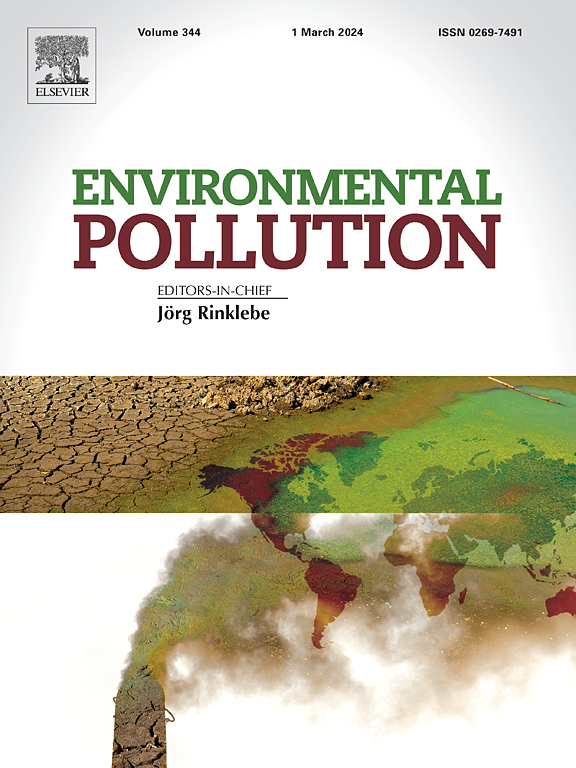Bioavailability and Resupply Dynamics of Thallium in Agricultural Soils Affected by Lead-Zinc Mining: In-Situ Insights from DGT-DIFS Modeling
IF 7.3
2区 环境科学与生态学
Q1 ENVIRONMENTAL SCIENCES
引用次数: 0
Abstract
Thallium (Tl), with higher toxicity and bioaccumulation potential than mercury (Hg), cadmium (Cd), and lead (Pb), poses serious ecological and food safety threats in mining-impacted agricultural systems. Despite this, its in-situ bioavailability and desorption kinetics in soil remain poorly understood, particularly in lead-zinc mineral-rich regions of southwestern China. In this study, we combined the Diffusive Gradients in Thin-Films (DGT) technique, the DGT-Induced Fluxes in Soils (DIFS) model, and path analysis to comprehensively investigate Tl mobility, bioavailability, and its environmental controls. A total of 29 soil samples from lead-zinc mining, smelting, and processing zones were analyzed. Over 59% of the soil samples exceeded the 1 mg/kg Tl threshold adopted in Germany, Canada, and Switzerland, with Tl enriched in ∼200 nm soil particles. DGT-measured labile Tl concentrations ranged from 0.03 to 1.71 μg/L, reaching peak levels in smelting areas, where weak acid-extractable Tl accounted for 2.9%-22.2% of the total. DIFS modeling revealed rapid resupply of Tl from the solid phase in contaminated soils (Tc = 15.9 s), indicating high environmental mobility. Path analysis identified total soil Tl content and cation exchange capacity as the dominant direct factors controlling Tl bioavailability, with standardized path coefficients of 0.49 and -0.33, respectively. Notably, manganese oxides indirectly enhanced Tl bioavailability (indirect coefficient = 0.37) by facilitating Tl accumulation and release, highlighting their dual role in both pollutant transport and potential remediation. This study provides novel mechanistic insights into Tl behavior in contaminated soils and demonstrates the strength of DGT-DIFS as a robust in-situ tool for evaluating heavy metal risks and informing soil pollution management strategies.

受铅锌开采影响的农业土壤中铊的生物有效性和再补给动态:基于DGT-DIFS模型的原位观察
铊(Tl)具有比汞(Hg)、镉(Cd)和铅(Pb)更高的毒性和生物蓄积潜力,对受采矿影响的农业系统构成严重的生态和食品安全威胁。尽管如此,其在土壤中的原位生物有效性和解吸动力学仍然知之甚少,特别是在中国西南富含铅锌矿的地区。在这项研究中,我们结合了薄膜扩散梯度(DGT)技术、DGT诱导土壤通量(DIFS)模型和通径分析,全面研究了Tl的迁移率、生物利用度及其环境控制。对来自铅锌开采、冶炼和加工地区的29个土壤样品进行了分析。超过59%的土壤样品超过了德国、加拿大和瑞士采用的1 mg/kg Tl阈值,Tl富集在~ 200 nm的土壤颗粒中。dgt测定的稳定Tl浓度范围为0.03 ~ 1.71 μg/L,在冶炼区达到峰值,弱酸可萃取Tl占总Tl的2.9% ~ 22.2%。DIFS模型显示污染土壤中Tl从固相快速补给(Tc = 15.9 s),表明环境流动性高。通径分析表明,土壤全Tl含量和阳离子交换容量是控制土壤Tl生物有效性的主要直接因子,标准化通径系数分别为0.49和-0.33。值得注意的是,锰氧化物通过促进硫的积累和释放,间接提高了硫的生物利用度(间接系数= 0.37),突出了锰氧化物在污染物运输和潜在修复中的双重作用。该研究为土壤中重金属的行为提供了新的机制见解,并证明了DGT-DIFS作为评估重金属风险和指导土壤污染管理策略的强大原位工具的优势。
本文章由计算机程序翻译,如有差异,请以英文原文为准。
求助全文
约1分钟内获得全文
求助全文
来源期刊

Environmental Pollution
环境科学-环境科学
CiteScore
16.00
自引率
6.70%
发文量
2082
审稿时长
2.9 months
期刊介绍:
Environmental Pollution is an international peer-reviewed journal that publishes high-quality research papers and review articles covering all aspects of environmental pollution and its impacts on ecosystems and human health.
Subject areas include, but are not limited to:
• Sources and occurrences of pollutants that are clearly defined and measured in environmental compartments, food and food-related items, and human bodies;
• Interlinks between contaminant exposure and biological, ecological, and human health effects, including those of climate change;
• Contaminants of emerging concerns (including but not limited to antibiotic resistant microorganisms or genes, microplastics/nanoplastics, electronic wastes, light, and noise) and/or their biological, ecological, or human health effects;
• Laboratory and field studies on the remediation/mitigation of environmental pollution via new techniques and with clear links to biological, ecological, or human health effects;
• Modeling of pollution processes, patterns, or trends that is of clear environmental and/or human health interest;
• New techniques that measure and examine environmental occurrences, transport, behavior, and effects of pollutants within the environment or the laboratory, provided that they can be clearly used to address problems within regional or global environmental compartments.
 求助内容:
求助内容: 应助结果提醒方式:
应助结果提醒方式:


